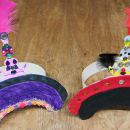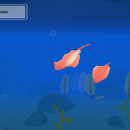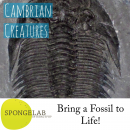Activity: Sustainable Style: Design a Lifer
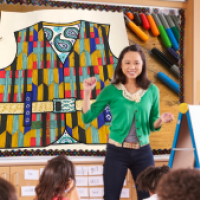
What if artist Noelle Hamlyn invited you to add your own Lifer to the Lifers exhibition?
You can also download this activity as part of our Sustainable Style Workbook [link coming soon]
Sustainable Style is inspired by the Lifers exhibition at ROM created by artist Noelle Hamlyn.
In 2019, Noelle collected some life jackets that had washed up on a beach, and these life jackets inspired the idea behind Lifers.
Noelle found previously used clothing in thrift stores and other places, and tailored them to cover the life jackets.
By connecting these two objects, Noelle invites people to think about:
- Our relationship with the clothes we wear
- The impact of the fashion industry on water and climate change
- What we should consider important to us as the climate continues to change
Imagine that Noelle invited you to add your own Lifer to this exhibition. What would you design?
Learning Goals
- Find personal connections in the immersive experience of Lifers.
- Reflect critically on the lifespan of our clothing and the impact the fashion industry has on water quality and climate change.
- Create an artwork in a medium of choice that explores this reflection in connection with a personal item of clothing.
- Explain the meaning behind the artwork in an artist’s statement.
Background Information
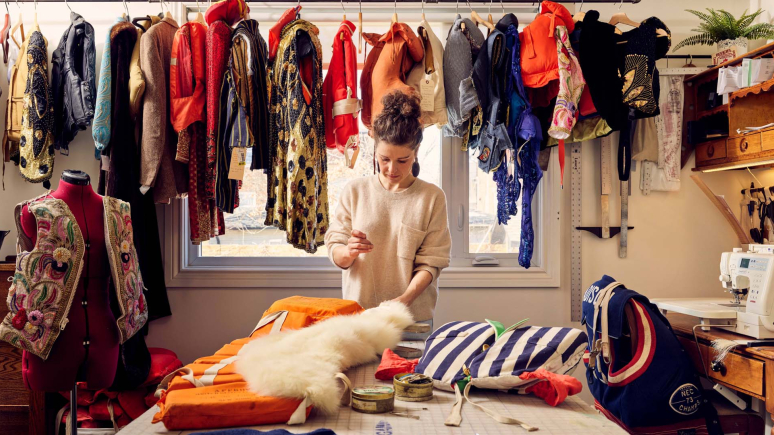 When Noelle is creating a Lifer, she thinks about the style of the clothing, how it was originally meant to be worn, how it was made, what the worn spots say about how its original owner wore it, and how it was decorated.
When Noelle is creating a Lifer, she thinks about the style of the clothing, how it was originally meant to be worn, how it was made, what the worn spots say about how its original owner wore it, and how it was decorated.
Noelle wants to remind us that every piece of clothing holds a story worth preserving, and Lifers help to tell that story.
At the same time, Lifers also make us think about how the ways we make and use our clothes affects the Earth around us, The effects of the fashion industry affect water, the climate, the workers involved, and the waste we produce.[Sustainable Style Tour]
By putting the effort into creating something like a Lifer, we can train ourselves to think more carefully about how our actions affect these “Four Ws,” and how we can imagine better climate futures.
Materials
- Sustainable Style Tour
- Design a Lifer worksheet [Google] [Word] [PDF]
- Pencil
- Eraser
- Colouring tools (marker, paint, etc.)
- Glue or glue sticks
- Fabric scraps (optional)
- Digital design tools (optional)
Preparation
• Prep and print materials
Instructions
Step 1
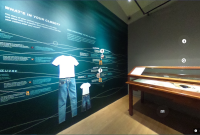
Explore the Sustainable Style tour to discover how the fashion industry affects Water, Warming, Workers, and Waste
Step 2
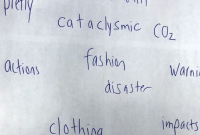
As you explore, write down some words that you think are important.
These could be words from the Lifers information or other stops around ROM, or feelings that they make you feel.
Step 3
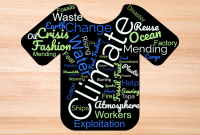
Use an extra piece of paper, a Google or Powerpoint Slide Deck, or a word cloud generator to give weight to your words in step 2.
Words that you think are more important should be larger, and words that you think are less important should be smaller.
Arrange your words into a word cloud, or use a word cloud generator to do it for you.
Step 4
Using the word cloud you have created, choose something you wear now (or have worn in the past) that:
- Is important to you
- You can connect to some or all of the words in your word cloud, especially the bigger ones.
Describe the piece of clothing you chose, and why you chose it.
Step 5
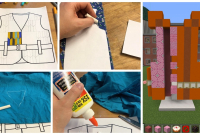
“Tailor” the piece of clothing you chose in Step 4 to fit onto a Lifer. You could:
- Draw your design onto the Lifer template and colour it in.
- Cut apart photos of your piece of clothing and use the pieces to cover your Lifer template. (Only do this if you don’t wear it any more!)
- If your chosen clothing is part of the Class Depository [link coming soon], cut scraps of fabric and use them to cover your Lifer template.
- Use digital tools and photos of your piece of clothing to cover a digital version of your Lifer.
Follow your teacher’s instructions about how they want you to create your Lifer.
Step 6
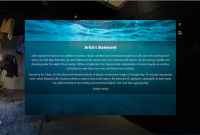
When creating a display of art like Lifers, artists will write an Artist’s Statement to explain the meaning behind the art.
Find and read Noelle Hamlyn’s Artist Statement in the Sustainable Style Tour..
Step 7
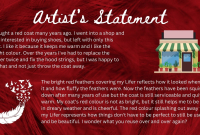
Write your own Artist’s Statement for your lifer.
Step 8
(Optional)
Turn your Lifers, artist’s statements, and word clouds into your own classroom Lifers exhibition.
Follow-Up
Thought Questions:
- What do you wonder about clothing and fashion?
- What did you discover about clothing by exploring the Lifers exhibition?
- How can clothing help tell someone’s story?
- How can art inspire change?
Extension Activities
Do one of the other activities in the Sustainable Style series, or explore the Sustainable Style Minecraft world [coming soon]

